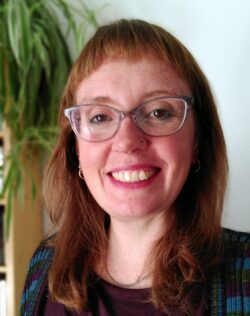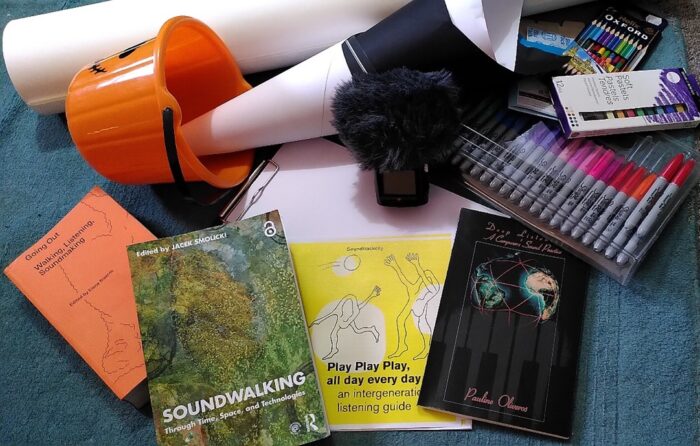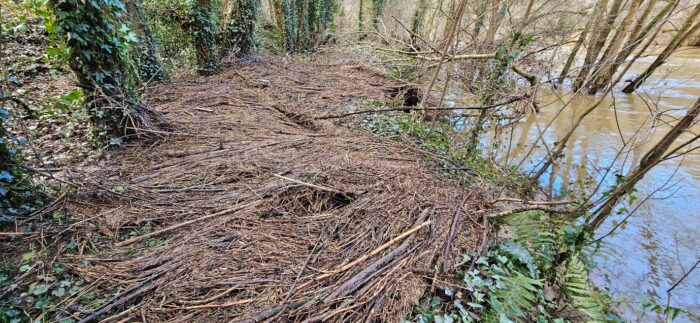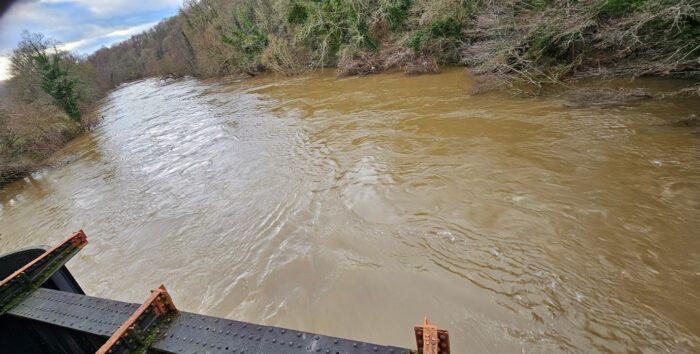Date: 20/02/2024
Author: Bethan Prosser

Bio:
Dr Bethan Prosser is a an SCDTP post-doctoral fellow exploring and extending the applications of her methodology she developed during her PhD: participatory listening research. To welcome in 2024, she recently co-created a listening retreat with the project’s community partner, Bela Emerson from Brighton & Hove Music for Connection (BHMC – the city’s specialist community music organisation). Here Bethan shares a little about their experience and how it contributes to her post-doctoral work…
Planning a listening retreat
There’s almost too much to say about our listening retreat weekend – I’m still buzzing and processing. If I start at the beginning, we go back to last summer when Bela had the inspired idea to go away together and explore a new place through our listening practice we have been developing. Sometimes opportunities align – both of us are currently in a fortunate position to explore, reflect, and expand our practices through different funding schemes (Bela through a DYCP grant and myself through my ESRC post-doctoral project). The first weekend in January (2024) appeared to be a free moment to get away and take some time to share and experiment with different practices relevant to a joint area of work: Interactive Listening Walks (ILWs). ILWs are accessible and restorative sessions for people to engage with the environment using their ears to guide them. One of my post-doc work strands is creating ILWs in three neighbourhoods across the Sussex coast to engage people in my PhD research findings on seaside gentrification.
I have to admit, when the weekend rolled round, I doubted our judgement of going away in the wintry cold, with fewer hours of daylight and lower energy levels to draw on in the face of storms and floods. But we agreed to be gentle, and simply keep a curious open mind to what we could create together. Before the weekend, we pooled ideas of activities and exercises we could experiment with, which Bela pulled into a rough schedule. This included: Bela sharing learning from her recent explorations in movement, embodiment, listening, and sound; improvising an interactive listening walk around the River Wye; and trying out new listening exercises.
We have developed this ILW format through several collaborative projects since I first did a PhD internship with BHMC. But there is aways more to explore and experiment with facilitating listening and walking to help people connect with their environments. In particular, as an outdoor activity, we are trying to find ways to be more adaptive and responsive to the weather (e.g. rain and strong winds that can lead to cancelling a walk) and embrace this aspect of our explorations of the sonic environment.
Our listening retreat journey

Figure 1: Listening resources (photo by author)
For our first night at Camp Hillcrest, we spread out an OS map, with the River Wye winding and snaking through, and delved into the different listening materials I’ve been gathering together (e.g. Oliveros, 2005, Biserna, 2022). We came up with a rough destination and a selection of exercises under three frames to help our spatial-sonic explorations: internal alignment (tuning into our capacities to listen), external alignment (responding to the sounds around us), and synthesis/integration (connecting this to the bigger picture e.g. whole environment or topic).

Figure 2: Flood debris (photo by Bela Emerson)
Next day, we set out to a spot along the River Wye, near Lower Lydney, that neither of us had been to before, with an idea to find an old bridge to crossover and act as an anchor for our explorations. We were greeted by Flooding and Road Closed signs, alongside a loudly droning water removal tanker and high-vis men brushing away the debris. Unsure if we could make it along the fast-flowing bloated river, we set off to find a path. Aided by this uncertainty, we took every moment to listen: picking out the range of textures and pitches of the river as it engulfed and swirled around trees and branches; mesmerised by a momentary bird paradise of small bird song delight; and crunching our way across thick layers of flood debris that stretched along longs stretches of the footpath.
We came to realise that we were walking in the wake of the water. We felt the first to be treading and listening, as the river receded, exploring what it had left behind and how it shaped the landscape anew.
And then through the bare branches, we glimpsed the bridge. The old iron bridge with its temporary scaffolded walkway provided a place for sonic explorations. We took the opportunity of a flat walkway to try out a listening-walking exercise and some audio recordings, under, on, and along the bridge.

Figure 3: River Wye from Stowfield bridge (photo by Bela Emerson)
Buoyed up by making it to the bridge, we ploughed on. But every path we took, we were thwarted by slipping, sliding, sticky squelching, streams, and surprise bogs. We decided to start making our way back and found ourselves under a welcoming cluster of trees – a perfect place to experiment with new listening-moving exercises, which we lost ourselves in for quite some time.
After making reflective notes, we set off stomping back over the bridge and known paths, sharing our discoveries on the way. We asserted a theme of the improvised listening walk – attention not destination. Returning to where we’d started, we took warm respite in the village pub, welcomed by the wood burner, friendly staff and locally brewed beer.
Capturing & reflecting

Figure 4: Edited photo of wall art at Camp Hillcrest (edited photo by author)
It was an intense exploration, that we gently reflected on throughout the evening and into the next morning. Gathered around the kitchen table, we captured and reflected on what we had gained from the weekend, what we could bring into our work – individually and jointly – and future hopes for and applications of our Interactive Listening Walk format.
For both of us, it was a restorative and refreshing start of the year ahead. For myself, it asserts my continued intention of bringing creative sensory practices into my academic approach. These more free-flowing, goal-freeing explorations help to oil my wrangles with extending and applying participatory listening research. After the weekend, I played with creating a mini digital story as a way of capturing and sharing the experience, which you can watch here.
Bela and I are currently grappling with how to use our ILW format as a tool for engaging people in research findings. These new gentrification ILWs are challenging on several levels: the settings (three connected but different neighbourhoods), the sonic environments (busy urban soundscapes as opposed to restorative green spaces), the content (rich and complex research data) and themes (urban change, heritagisation, financialisation, housing inequality, im/mobilities etc). But this listening retreat spurs us forward in these pursuits with new tools and techniques to aid our creations over the year ahead…
References
Biserna, E. (2022) Going Out: Walking, Listening, Soundmaking. Brussels: Umland.
Oliveros, P. (2005) Deep Listening: A Composer’s Sound Practice. Bloomington: iUniverse.